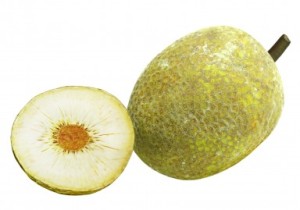That’s right. A breadfruit. It’s native to Tahiti and was introduced to Jamaica in 1793 by Captain Bligh. So why are the Jamaicans keeping all these great fruits to themselves? Granted, the breadfruit is tropical and can’t be grown in the majority of the US, but we could at least know about it, right?
The breadfruit is a large green fruit, usually around 10  inches in diameter. It has a pebbly green skin and flesh with a potato like texture. Breadfruit is picked and eaten before it ripens. Most varieties can cause severe stomach upset if eaten raw. A common practice is to boil them twice and throw the water away to avoid any issues from the fruit. However, they can be used in place of any of your starchy vegetables, rice, or pasta. And breadfruit is pretty versatile. It can be cooked and served in a number of ways. It’s not uncommon for it to turn up in preserves or beverages.
inches in diameter. It has a pebbly green skin and flesh with a potato like texture. Breadfruit is picked and eaten before it ripens. Most varieties can cause severe stomach upset if eaten raw. A common practice is to boil them twice and throw the water away to avoid any issues from the fruit. However, they can be used in place of any of your starchy vegetables, rice, or pasta. And breadfruit is pretty versatile. It can be cooked and served in a number of ways. It’s not uncommon for it to turn up in preserves or beverages.
But why call it a breadfruit? It tastes doughy like bread, but has more moisture. There are both seeded and seedless varieties. The seedless breadfruit is low in protein, but the seeds are considerably higher and therefore of more value as food.
The breadfruit tree can grow up to 85 feet tall. These trees require temperatures between 60° to 100°F, annual rainfall of 80-100 inches, and relative humidity of 70-80%. This is the main reas on why we rarely see breadfruit in the US. Generally the rind of the fruit is green at first, then turning a yellowish-green, yellow or yellow-brown when ripe, although there is one variety that is lavender. When it is green the fruit is hard with a white, starchy and fibrous interior. When the fruit is fully ripe, it becomes somewhat soft with a cream or yellow, pasty interior. It also has a slightly sweet fragrance.
on why we rarely see breadfruit in the US. Generally the rind of the fruit is green at first, then turning a yellowish-green, yellow or yellow-brown when ripe, although there is one variety that is lavender. When it is green the fruit is hard with a white, starchy and fibrous interior. When the fruit is fully ripe, it becomes somewhat soft with a cream or yellow, pasty interior. It also has a slightly sweet fragrance.
Small drops of latex appear on the surface of the fruit when it is mature. Similar to a banana or plantain, the breadfruit can be eaten ripe as a fruit or under ripe as a vegetable. Soft or overripe breadfruit is used to make chips. These are currently being manufactured in Trinidad and Barbados. In some areas, such as Jamaica, Puerto Rico, and the South Pacific, fallen male flower spikes are boiled, peeled, and then eaten as vegetables. They can also be candied by recooking them in syrup and then rolled in powdered sugar and sundried.
Dried breadfruit has been made into flour. It is being explored as to whether it is a viable option to substitute breadfruit in part for wheat flour in bread making. The combination of the two proves more nutritious than wheat flour alone. Breadfruit flour is richer in lysine and other amino acids than wheat flour. In Jamaica, breadfruit flour is boiled and sweetened and then eaten as porridge.
Breadfruit has some other uses as well. Its leaves are commonly eaten by livestock such as cattle, goats, horses, and pigs. The latex, after being boiled with coconut oil, is used for caulking boats. It can also be mixed with colored earth and used as a paint for boats. The wood of the tree is light in weight but strong, elastic, and resistant to termites. Therefore, it makes it a good wood to be used in construction and for furniture. It is also quite in demand for surfboards. Traditional Hawaiian drums are even made out of breadfruit trunks.
Perhaps most interestingly, the breadfruit also has a number of medicinal uses. In some areas, such as Trinidad and the Bahamas, the breadfruit leaves are believed to lower blood pressure. Some also say they can relieve asthma. Leaves can be crushed and applied to the tongue as a treatment for thrush. So did we really just get rid of beta-blockers, inhalers, and the need for antibiotics to cure thrush because of a fruit? Seems a lot easier, doesn’t it?
The leaf juice is even employed as ear-drops and skin infections can be treated with ashes of burned leaves. A powder of the roasted leaves is used as a remedy for an enlarged spleen. So a powder from a fruit or risk a surgery? Hardly seems like choice to me. Some even say that the leaves can be used as a remedy for headaches. And if you’re like me and you get chronic headaches and migraines, you’d try just about anything to help them. Toasted flowers are rubbed on the gums near an aching tooth. This sounds so easy! The latex is used on skin diseases and is bandaged on the spine to relieve sciatica. And finally, diluted latex is taken internally to overcome diarrhea.
I’m a skeptic myself, so until I try these I’m not sure I believe them either. But even if only half of them worked, wouldn’t it be amazing?
Images courtesy of Jamaican-Recipes.com & CC-BY-SA-3.0 (http://creativecommons.org/licenses/by-sa/3.0/)], via Wikimedia Commons
